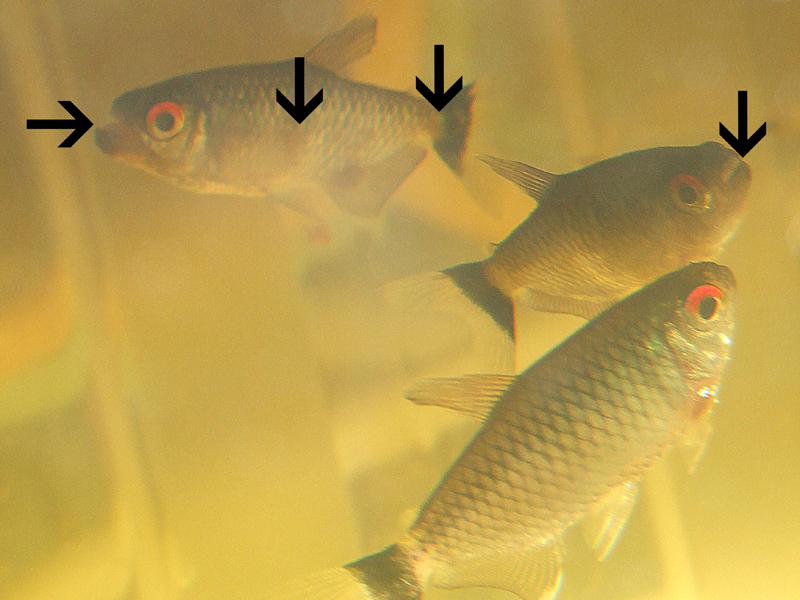
The tank has been set up (with that single tetra in it) for 11 days now. Here's my problem: I've never done a fish-in cycle before, and while, the tiny tetra is the only fish in my 10g right now (so he's not contributing to ammonia rise very much), I'm having trouble getting my cycle to progress in the right direction (and didn't want to add more fish until cycling was complete). I have plans to get 4-5 buddies for him as soon as it's appropriate. I know that a 20g would be more ideal for a tetra species tank, but for the next year and a half, my rental agreement limits me to a 10g. After I pointed out a few times how inappropriate this environment was for him, the friend sent him home with me. He was living with a friend, in a 2 gallon bowl with an airstone.

I recently "rescued" (curse of the veterinary student it's impossible to say no to critters in need, LoL) a single Serpae Red Minor Tetra. This morning I counted 7! A new little one made his appearance with the adults.I've been in college, unable to have a tank for the past 8 years. I started with a school of 6 Red Eye Tetras, four weeks ago in a large community tank with large pebbles for gravel and lots of potted plants. If you are looking for fishes to be active, these are not it. They do prefer to hang around at the top of the tank. Indeed, these red eye tetras are very friendly and don't bother the other fishes in a community tank. I would definitely recommend them to others! They are very easy to feed and quite peaceful. While most of the tetras I keep ( rummy nose tetra, neon tetras and glowlight tetras) seem to stay on the bottom of the tank, these red eyes stay towards the top of the tank. They keep to themselves most of the time and never bother any of their tank mates. They red eye tetra eye color is incredible and the look of a school of these tetras is wonderful to watch. I must say that this is one of the best tetras that I've kept. Photo Credit : Photos copyright JJPhoto.dk Gender : May be able to tell a difference in males and females when the female gets "fatter" or fuller. Tank Region : All over, but seems to congregate near protected areas towards the bottom of the tank most of the time.

Flakes, frozen, freeze dried and may nibble at some aquarium plants. They may nip fins if kept solitary.įish Disease : Freshwater Fish Disease - Diagnose, Symptoms and Treatmentĭiet / Foods : The Red Eye Tetra should eat most common aquarium foods. Tank Mates : You don't want to keep them with more boisterous or overly aggressive tank mates. The adults may eat the eggs.Īquarium Size : 30 gallons (114 liters) - this is a schooling fish and should be kept in groups of 5 or more. Temperament / Behavior : A very peaceful tetra that needs to be in a school of 5 or more.īreeding : They will scatter their eggs on the substrate. Origin / Habitat : South America, Brazil, River Basin areas Scientific Name : Moenkhausia sanctaefilomenaeĬommon Names : Yellowhead Characin, Yellowhead Tetra, Yellow-banded moenkhausia Give them a variety of vitamin enriched foods for best results. They should accept nearly all aquarium foods including flakes, frozen and freeze dried fish food. They are egg scatterers and will abandon the eggs and even eat them if not separated. They do make a great freshwater aquarium beginner fish because they can be relatively hardy and their peaceful nature.īreeding them can be challenging if not kept in a separate, bare bottom breeding tank.

Other tetras may pick on them at times, so keep an eye on them. The Red Eye Tetra is very peaceful if kept in groups, but may get a little fin nippy if kept as a single. The first half of the caudal fin is black and the main part of the body is silver. The top of the eye socket is red, hence the name. This tetra makes an ideal member of a peaceful community tank with aquarium plants and should bring a decent amount of activity to your aquarium. The Red Eye Tetra is a great little tetra that needs to be kept in a school of 5 or more.


 0 kommentar(er)
0 kommentar(er)
